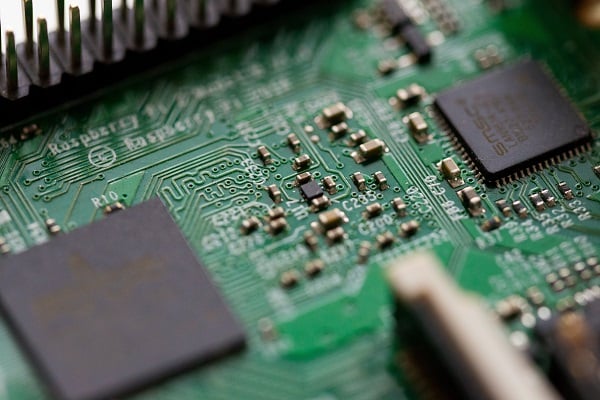
In recent years, new soldering technologies have emerged to challenge traditional wave soldering as the most prominent soldering technology in electronics manufacturing and SMT processes. Depending on the restrictions, requirements and features of the PCBs, other technologies such as press-fit application, selective soldering or laser soldering can be used to gain new advantages. In this article, we take a look at these three technologies and the benefits they offer in manufacturing.
Press-fit
Press-fit technology, also known as interference or friction fit, is an increasingly popular method for THT (through-hole technology) PCB assemblies. Press-fitting allows control of the force and speed at insertion of single and multiple pins and terminals, requiring no subsequent soldering while providing a high level of retained strength. In many cases, press-fit has removed the need for soldering for on-board interconnects altogether. This reduces costs and challenges of integrating sophisticated and difficult processes such as odd-shape placement of components or connectors and soldering lines.
Press-fit technology is a proven and widely adopted technology especially in the telecommunications and automotive industry. The press-fit pin connections are very versatile and can be used on both the top and bottom sides of the PCB, enabling flexible double-sided through-hole and SMT PCB assemblies. The solderless press-fit technology means all THT processes can be carried out completely without interconnect assembly. Also, as components and modules grow smaller making boards more densely populated, press-fit technology can save valuable space and help protect sensitive components efficiently.
Benefits of press-fit technology:
- Avoids solder cracks caused by thermal processes (shrinkage-expansion)
- Controls the force and speed of component insertion
- Cost reduction by energy savings, especially when skipping soldering lines
- Cost reduction on floor space, especially when integrating difficult process phases into one line, such as odd-shape placement and soldering
- Eliminates need for oven temperature control
- Eliminates need for soldering of interconnect systems
- High current wire-to-board connections made possible
- High level of retention strength
- High quality connection, resistant to vibrations
- Improved automation and processes with in-line solution
- Protection of sensitive components
Selective soldering
Selective soldering is a process in which components are selectively soldered to printed circuit boards (PCBs). Selective soldering is typically used in situations where components or modules can be damaged by the temperatures of reflow ovens or wave soldering in SMT processes. In fact, selective soldering is a varied approach based on wave soldering, and is used for soldering PCBs that are assembled either completely or partly with through-hole components. In short, selective soldering is a precise and cost-saving technique for through-hole soldering that holds many advantages over wave soldering.
Selective soldering can be split into three separate stages:
1) the fluxing of the board
2) preheating of the PCB assembly
3) soldering.
Before this selective soldering process is started, PCBs usually have been through a reflow process, exposing previously soldered parts. This requires careful and sufficient precision in order to avoid damaging the parts that are exclusive to the secondary soldering stage.
Benefits of selective soldering:
- Cost-effective technology that eliminates the use of costly wave solder pallets and masks
- Guaranteed reproducibility
- High quality of solder joints
- Non-contact application
- Precise and detailed
- Safe and quick process optimization
- Secure and reliable solder joints without component overheating
- Suitable for low and high volume production
Laser soldering
Laser soldering is a fairly new approach to the soldering process. It is often applied as selective laser soldering due to its characteristics. As with selective soldering, laser soldering could be the best choice for soldering when there are limits in components’ temperature-sensitivity or lack of space on the PCB. Unlike with tip soldering, in laser soldering the heat and energy is transferred via a laser beam instead of a heated tip. This means the heat is more precise and more controllable. Laser soldering excels especially when utilized in an automated assembly process or when working with sensitive and small components.
The increased adoption of multi-layered components, PCBs growing smaller and the introduction of ultrafine electronic circuit boards has caused new technologies and applications, like laser soldering, to emerge. However, laser soldering is not a one-size-fits-all option to traditional tip or wave soldering. Laser soldering can be a better fit e.g. for applications that don’t have soldering volumes that would require wave soldering or reflow ovens, or where the manufacturing process includes selectively soldering high-density boards and sensitive components in limited accessibility areas of the PCB.
Benefits of laser soldering
- Ability to solder SMD components in small quantities (1–5 pcs)
- Efficient and homogeneous heat input
- Efficient heat application and solder supply enables stable automation in soldering
- Fine grain size due to rapid cooling, resulting in better fatigue properties
- Flexibility, no need for soldering pallets
- High precision
- Low and localized heat input – soldering of temperature-sensitive components possible
- Low maintenance and high maintainability
- Minimized stress load on the PCB through non-contact processing
- No risk of damaging adjacent components
- Non-contact processing for joining in tight or limited spaces
- Optimized temperature time profile for best results – The soldering temperature can be regulated according to a preset profile
- Process from top as well as from bottom side of PCB panels
- Processing of metallic work pieces of very small geometries
- Quick power controllability
If you're interested in finding out more about the possibilities of press-fit and laser soldering for manufacturing automation solutions, please contact us.
